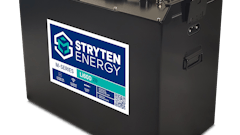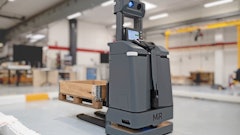
Sometimes you just have to take a leap of faith. That’s what Armand Page did when he decided to build a distribution center around an unusual method for picking slow moving items.
Page is the vice president of operations and IT for Jake’s Finer Foods, a full-line foodservice distributor serving independent restaurants, multi-unit restaurants and foodservice retail companies. During the past three years, under his guidance, the company designed and built a 180,000-square-foot distribution center and corporate headquarters in Houston.
The DC is Phase One of an eventual development of a 360,000-square-foot refrigerated facility. It uses technologies and material handling systems that will increase efficiency, reduce costs and significantly cut energy use and environmental waste—and help the company save $4.6 million dollars over the next five years.
For its environmental efforts as well as its commitment to passing long-term savings on to its customers, Jake’s Finer Foods has been named the winner of Food Logistics’ Golden Pallet Award in the large distribution center category.
The Golden Pallet Awards, sponsored by Food Logistics, are the first food industry awards to recognize excellence in warehousing. Two more Golden Pallet award winners will be profiled in upcoming issues of FL.
Jake’s, which posted $80 million in revenue last year, was founded in 1946. The family-run company has come a long way since Kervin E. Jacob (Jake) started the business delivering eggs door-to-door to household customers. Today it sells more than 1 million eggs a week and delivers 8,000 SKUs to 1,500 customers in Eastern Texas and Western Louisiana.
“We simply outgrew our facility. The old warehouse was just under 80,000 square feet across three separate buildings,” says Page. “We consolidated the buildings into one and more than doubled the square footage and tripled the cube in this new DC.”
The warehouse, which opened this past February, provides slots for over 20,000 items and more than 4.3 million feet of cubic storage, including seven temperature zones design to maintain ideal product storage conditions. The cornerstone of the facility, however, is a unique solution—Page designed the facility around a pick path and rack system for slow movers that uses pallet jacks with rising platforms, taking up significantly less space than the narrow aisle racking it used at the old warehouse.
Saving For The Future
At the old warehouse, Jake’s was utilizing between 90 percent to 95 of its storage slots. The company had a costly and inefficient floating planned item retrieval (PIR) system for slow movers that brought product to a central point where they would be collated into a customer’s order—thereby handling the product twice.
“The PIR five-aisle man up areas required us to pull the product and move it to a merge location and about a third of our errors were coming from that merge area,” says Page. “Product would get on the wrong pallet. In addition, the hard-to-reach pick slots in the narrow aisles increased order filling time and created safety issues.”
After visiting 16 distribution centers to get ideas on how to lay out the new facility, Jake’s decided to work with Atlet Inc., a lift truck manufacturer based in Anaheim, CA. Page says he saw Atlet’s Tempo pallet jacks in action at one facility that had designed the pick paths and racking around the Tempo, and was impressed.
“We realized that if we used the Tempo, we could get rid of the PIR and take all of the slow moving products and fit them into a six by nine foot area,” says Page. “The Tempo would give us the ability to pick at a higher slot—its platform raises us up and gets us to that level. And we could put more slots into the pick path.”
According to Atlet, the Tempo can cut pick paths in half by allowing distributors to pick faster moving product at a higher level. The cab rises 37 and a half inches, allowing the operator to safely and easily reach products that cannot be moved with a typical pallet jack. The typical driver spends about 80 percent of his time traveling and only 20 percent actually handling cases—averaging out to 72 cases per hour. The Tempo can bring this up to 216 cases per hour by allowing drivers to drastically shorten their pick packs. At Jake’s, the best selector is now pulling 240 cases per hour—up from 180 cases at the old facility.
“And those numbers keep going up. We were able to reduce our staff from 14 order selectors at the old facility to eight here,” says Page.
The solution has increased easily accessible pick slots by 60 percent and created almost two-thirds more storage space with the new warehouse design.
“By increasing our number of pick slots substantially, we got back two years of growth in expansion,” says Page. “In my estimation, we’re saving $2.7 million in expansion costs that we’ll forgo for a couple of years just by using the Atlet equipment.”
In addition, Page believes the expected 200 cases per hour selection rate will be an additional $365,000 savings per year or $1.85 million saved over the next five years.
Safety is another benefit of the system, says Page. “We were having between one and two accidents a month at our other facility and we haven’t had a single accident here with this new equipment. Our employees love these pallet jacks—one of the things they really like is when the platform raises up they feel safe because of the security bar, which creates a barrier so they can’t fall off the truck.”
Page believes the reduction of accidents will save the company more than $40,000 a year in work-related injuries.
The Atlet Tempo’s were pricier than similar models from other vendors, but Page believes they were well worth it. “We would have had to buy more expensive equipment had we gone with the narrow aisles, but the ROI we’ve gotten with Atlet is tremendous. By purchasing this equipment, we saved $186,000 before we opened the doors of the new DC.”
Jake’s runs on Retalix’s Power Warehouse software. The company, which has been using Power Warehouse for more than a decade, is using the warehouse management system (WMS) to accurately track product date fields to assure the freshest and safest products to its customers. It’s been using Vocollect Inc.’s voice technology for about 18 months.
Reducing The Carbon Footprint
The DC, which is HACCP certified and exceeds bioterrorism food handling requirements, represents a tremendous leap forward for Jake’s, in economic, safety and ecological terms.
“We wanted to find products and technologies to reduce our carbon footprint,” says Page, “but some of the things we did will not only affect the environment, but have a real impact on the quality and safety of our products.”
For example, the facility features a fully refrigerated dock, including a minus 20 degree storage facility for ice cream. This ensures that food is kept at proper temperatures throughout its handling and storage. The company is using an ammonia cooling system that is 30 percent more efficient than traditional cooling methods.
In addition, Jake’s utilizes a vortex non-chemical water purification system that permits greater reuse of water and ensures that it is environmentally safe when expelled.
“We’ve incorporated a high-tech automatic lighting system that is better than your average ‘green’ lighting standards, which will save us about $36,000 a year,” says Page.
Not bad for a company that started out in the egg business. “This is a gorgeous facility that was well thought out,” says Page. “We’re very proud of it—and we did it at a reasonable price.”
Jake’s Finer Foods At A Glance
Full-line distributor based in Houston
Founded: 1946
2009 sales volume: $80 million
Employees: 115 associates (including 24 in the warehouse)
Customer base: Serves more than 1,500 foodservice companies, independent restaurants, multi-unit restaurants and foodservice retailers
Service area: Texas, Louisiana
Size of warehouse: 180,000 square feet
Average number of SKUs: 2,000 dry; 2,000 refrigerated; 4,000 frozen
Average orders per day: 380
Average cartons shipped per day: 11,000
Inventory accuracy: 99.9 percent

























